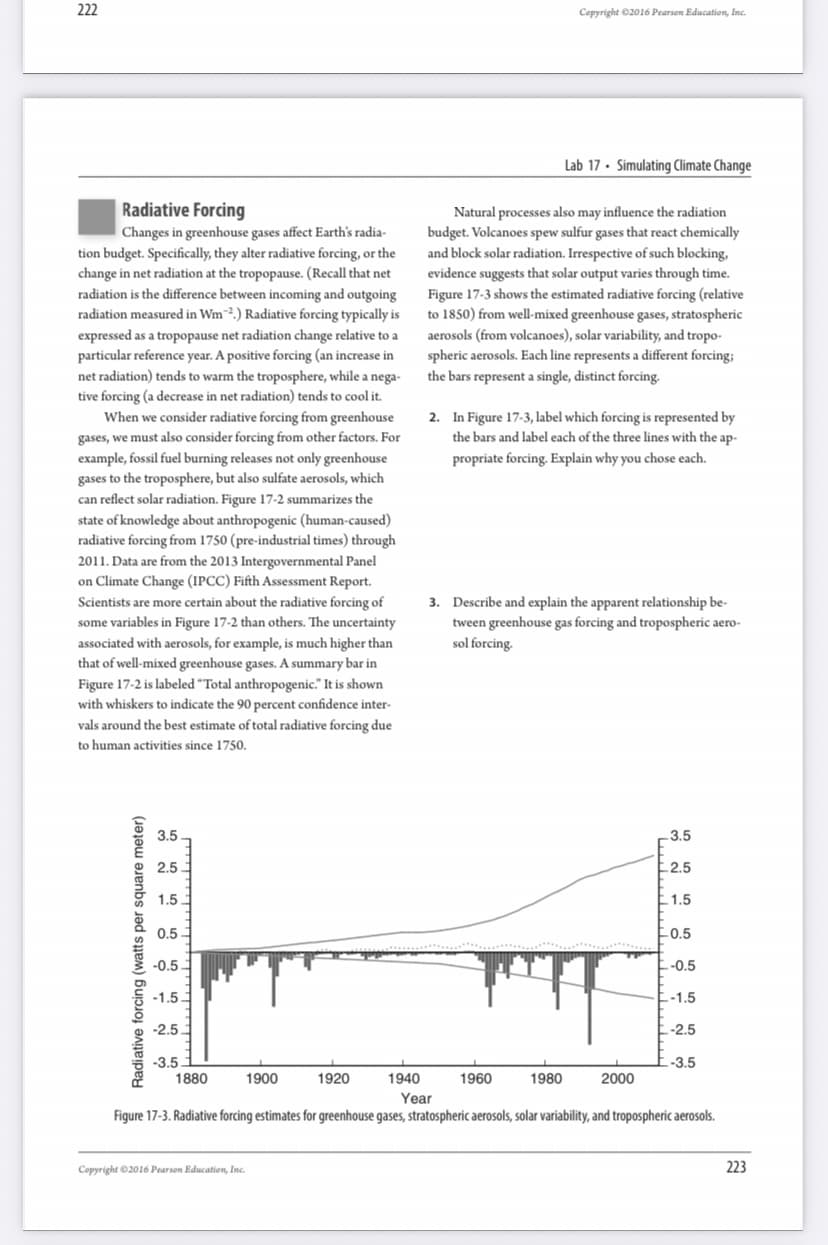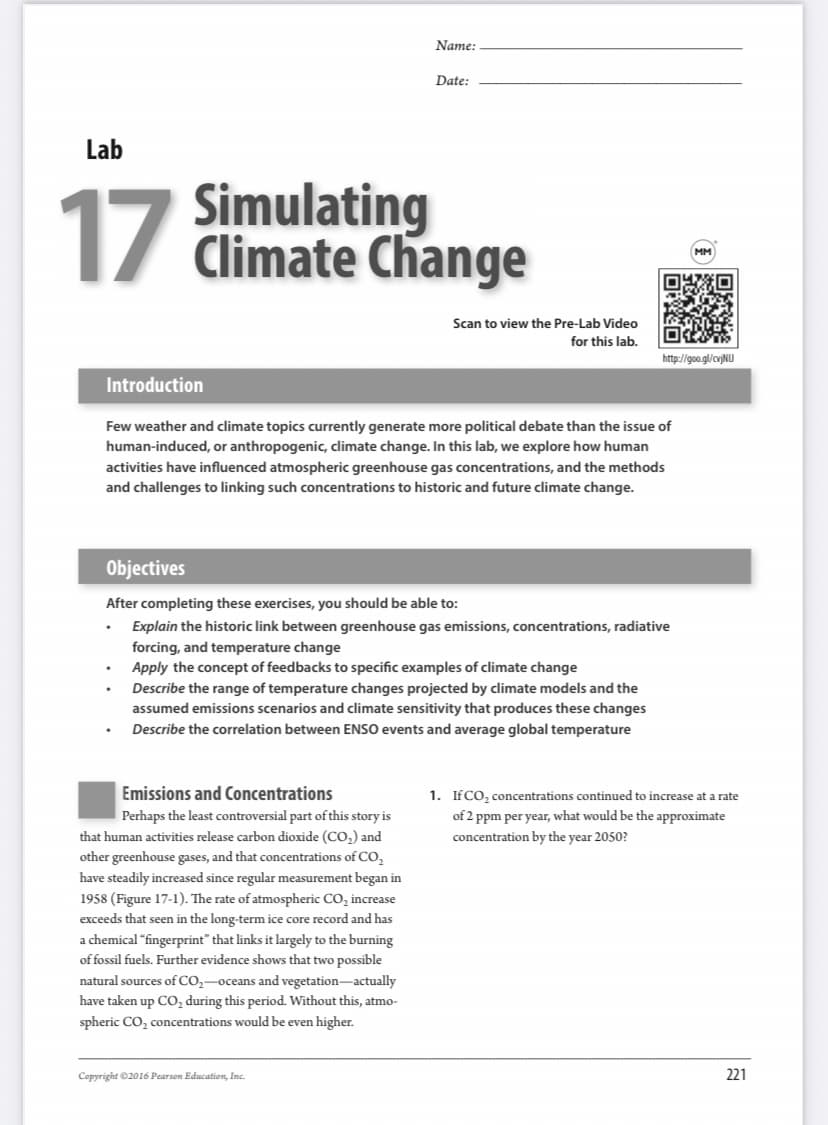2. In Figure 17-3, label which forcing is represented by the bars and label each of the three lines with the ap- propriate forcing. Explain why you chose each. When we consider radiative forcing from greenhouse es, we must also consider forcing from other factors. For mple, fossil fuel burning releases not only greenhouse es to the troposphere, but also sulfate aerosols, which reflect solar radiation. Figure 17-2 summarizes the e of knowledge about anthropogenic (human-caused) ative forcing from 1750 (pre-industrial times) through 1. Data are from the 2013 Intergovernmental Panel Climate Change (IPCC) Fifth Assessment Report. entists are more certain about the radiative forcing of ne variables in Figure 17-2 than others. The uncertainty ociated with aerosols, for example, is much higher than t of well-mixed greenhouse gases. A summary bar in ure 17-2 is labeled "Total anthropogenic." It is shown h whiskers to indicate the 90 percent confidence inter- around the best estimate of total radiative forcing due muman activities since 1750. 3. Describe and explain the apparent relationship be- tween greenhouse gas forcing and tropospheric aero- sol forcing. 3.5 3.5 2.5 2.5 1.5. E1.5 0.5- E0.5 -0.5. E-0.5 -1.5. E-1.5 -2.5. E-2.5 -3.5. 1880 -3.5 1900 1920 1940 1960 1980 2000 Year Figure 17-3. Radiative forcing estimates for greenhouse gases, stratospheric aerosols, solar variability, and tropospheric aerosols. Radiative forcing (watts per square meter)
2. In Figure 17-3, label which forcing is represented by the bars and label each of the three lines with the ap- propriate forcing. Explain why you chose each. When we consider radiative forcing from greenhouse es, we must also consider forcing from other factors. For mple, fossil fuel burning releases not only greenhouse es to the troposphere, but also sulfate aerosols, which reflect solar radiation. Figure 17-2 summarizes the e of knowledge about anthropogenic (human-caused) ative forcing from 1750 (pre-industrial times) through 1. Data are from the 2013 Intergovernmental Panel Climate Change (IPCC) Fifth Assessment Report. entists are more certain about the radiative forcing of ne variables in Figure 17-2 than others. The uncertainty ociated with aerosols, for example, is much higher than t of well-mixed greenhouse gases. A summary bar in ure 17-2 is labeled "Total anthropogenic." It is shown h whiskers to indicate the 90 percent confidence inter- around the best estimate of total radiative forcing due muman activities since 1750. 3. Describe and explain the apparent relationship be- tween greenhouse gas forcing and tropospheric aero- sol forcing. 3.5 3.5 2.5 2.5 1.5. E1.5 0.5- E0.5 -0.5. E-0.5 -1.5. E-1.5 -2.5. E-2.5 -3.5. 1880 -3.5 1900 1920 1940 1960 1980 2000 Year Figure 17-3. Radiative forcing estimates for greenhouse gases, stratospheric aerosols, solar variability, and tropospheric aerosols. Radiative forcing (watts per square meter)
Applications and Investigations in Earth Science (9th Edition)
9th Edition
ISBN:9780134746241
Author:Edward J. Tarbuck, Frederick K. Lutgens, Dennis G. Tasa
Publisher:Edward J. Tarbuck, Frederick K. Lutgens, Dennis G. Tasa
Chapter1: The Study Of Minerals
Section: Chapter Questions
Problem 1LR
Related questions
Question
100%

Transcribed Image Text:222
Copyright @2016 Pearson Education, Inc.
Lab 17 · Simulating Climate Change
Radiative Forcing
Natural processes also may influence the radiation
budget. Volcanoes spew sulfur gases that react chemically
and block solar radiation. Irrespective of such blocking,
evidence suggests that solar output varies through time.
Figure 17-3 shows the estimated radiative forcing (relative
to 1850) from well-mixed greenhouse gases, stratospheric
Changes in greenhouse gases affect Earth's radia-
tion budget. Specifically, they alter radiative forcing, or the
change in net radiation at the tropopause. (Recall that net
radiation is the difference between incoming and outgoing
radiation measured in Wm².) Radiative forcing typically is
expressed as a tropopause net radiation change relative to a
particular reference year. A positive forcing (an increase in
net radiation) tends to warm the troposphere, while a nega-
tive forcing (a decrease in net radiation) tends to cool it.
When we consider radiative forcing from greenhouse
aerosols (from volcanoes), solar variability, and tropo-
spheric aerosols. Each line represents a different forcing;
the bars represent a single, distinct forcing.
gases, we must also consider forcing from other factors. For
example, fossil fuel burning releases not only greenhouse
gases to the troposphere, but also sulfate aerosols, which
can reflect solar radiation. Figure 17-2 summarizes the
2. In Figure 17-3, label which forcing is represented by
the bars and label each of the three lines with the ap-
propriate forcing. Explain why you chose each.
state of knowledge about anthropogenic (human-caused)
radiative forcing from 1750 (pre-industrial times) through
2011. Data are from the 2013 Intergovernmental Panel
on Climate Change (IPCC) Fifth Assessment Report.
3. Describe and explain the apparent relationship be-
tween greenhouse gas forcing and tropospheric aero-
sol forcing.
Scientists are more certain about the radiative forcing of
some variables in Figure 17-2 than others. The uncertainty
associated with aerosols, for example, is much higher than
that of well-mixed greenhouse gases. A summary bar in
Figure 17-2 is labeled “Total anthropogenic." It is shown
with whiskers to indicate the 90 percent confidence inter-
vals around the best estimate of total radiative forcing due
to human activities since 1750.
3.5
3.5
2.5
- 2.5
1.5
1.5
0.5
-0.5
-0.5.
E-0.5
-1.5
-1.5
-2.5.
E-2.5
-3.5
-3.5
1880
1900
1920
1940
1960
1980
2000
Year
Figure 17-3. Radiative forcing estimates for greenhouse gases, stratospheric aerosols, solar variability, and tropospheric aerosols.
Copyright 02016 Pearson Education, Inc.
223
Radiative forcing (watts per square meter)

Transcribed Image Text:Name:
Date:
Lab
17
Simulating
1/ Climate Change
Scan to view the Pre-Lab Video
for this lab.
http://goo.gl/cv)NU
Introduction
Few weather and climate topics currently generate more political debate than the issue of
human-induced, or anthropogenic, climate change. In this lab, we explore how human
activities have influenced atmospheric greenhouse gas concentrations, and the methods
and challenges to linking such concentrations to historic and future climate change.
Objectives
After completing these exercises, you should be able to:
Explain the historic link between greenhouse gas emissions, concentrations, radiative
forcing, and temperature change
Apply the concept of feedbacks to specific examples of climate change
Describe the range of temperature changes projected by climate models and the
assumed emissions scenarios and climate sensitivity that produces these changes
Describe the correlation between ENSO events and average global temperature
Emissions and Concentrations
1. IFCO, concentrations continued to increase at a rate
Perhaps the least controversial part of this story is
that human activities release carbon dioxide (CO,) and
other greenhouse gases, and that concentrations of CO,
have steadily increased since regular measurement began in
1958 (Figure 17-1). The rate of atmospheric CO, increase
of 2 ppm per year, what would be the approximate
concentration by the year 2050?
exceeds that seen in the long-term ice core record and has
a chemical "fingerprint" that links it largely to the burning
of fossil fuels. Further evidence shows that two possible
natural sources of CO,-oceans and vegetation-actually
have taken up CO, during this period. Without this, atmo-
spheric CO, concentrations would be even higher.
Copyright ©2016 Pearson Education, Inc.
221
Expert Solution
This question has been solved!
Explore an expertly crafted, step-by-step solution for a thorough understanding of key concepts.
This is a popular solution!
Trending now
This is a popular solution!
Step by step
Solved in 4 steps

Recommended textbooks for you

Applications and Investigations in Earth Science …
Earth Science
ISBN:
9780134746241
Author:
Edward J. Tarbuck, Frederick K. Lutgens, Dennis G. Tasa
Publisher:
PEARSON

Exercises for Weather & Climate (9th Edition)
Earth Science
ISBN:
9780134041360
Author:
Greg Carbone
Publisher:
PEARSON

Environmental Science
Earth Science
ISBN:
9781260153125
Author:
William P Cunningham Prof., Mary Ann Cunningham Professor
Publisher:
McGraw-Hill Education

Applications and Investigations in Earth Science …
Earth Science
ISBN:
9780134746241
Author:
Edward J. Tarbuck, Frederick K. Lutgens, Dennis G. Tasa
Publisher:
PEARSON

Exercises for Weather & Climate (9th Edition)
Earth Science
ISBN:
9780134041360
Author:
Greg Carbone
Publisher:
PEARSON

Environmental Science
Earth Science
ISBN:
9781260153125
Author:
William P Cunningham Prof., Mary Ann Cunningham Professor
Publisher:
McGraw-Hill Education

Earth Science (15th Edition)
Earth Science
ISBN:
9780134543536
Author:
Edward J. Tarbuck, Frederick K. Lutgens, Dennis G. Tasa
Publisher:
PEARSON

Environmental Science (MindTap Course List)
Earth Science
ISBN:
9781337569613
Author:
G. Tyler Miller, Scott Spoolman
Publisher:
Cengage Learning

Physical Geology
Earth Science
ISBN:
9781259916823
Author:
Plummer, Charles C., CARLSON, Diane H., Hammersley, Lisa
Publisher:
Mcgraw-hill Education,